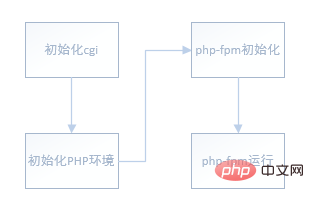How does phpfpm work?
php-fpm is a master (main)/worker (child) multi-process architecture, which is somewhat similar to the nginx design style. The master process is mainly responsible for CGI and PHP environment initialization, event monitoring, sub-process status, etc., and the worker process is responsible for processing PHP requests.

Operation principle
php-fpm adopts master/worker architecture design, the front is simple Describe the functions of the master and worker process modules. The operating principles of these two modules will be explained in detail below.
master process
The master process workflow is divided into 4 stages, as shown below:

1. cgi initialization phase: call the fcgi_init() and sapi_startup() functions respectively, register process signals and initialize the sapi_globals global variable.
2. PHP environment initialization phase: triggered by cgi_sapi_module.startup. The php_cgi_startup function is actually called, and php_cgi_startup internally calls php_module_startup for execution.
Main functions of php_module_startup:
a), load and parse php configuration;
b), load php module and record it in the function symbol table (function_table);
c), load zend extension;
d), set disabled functions and class library configuration;
e), register memory recovery method;
3, php -fpm initialization phase: execute the fpm_init() function. Responsible for parsing the php-fpm.conf file configuration, obtaining process-related parameters (the maximum number of files allowed to be opened by the process, etc.), initializing the process pool and event model and other operations.
4. php-fpm running phase: execute the fpm_run() function, and the main process will be blocked after running. This phase is divided into two parts: fork child process and loop event.
The fork child process part is handled by the fpm_children_create_initial function (Note: ondemand mode is created in the fpm_pctl_on_socket_accept function).
The loop event part is processed through the fpm_event_loop function, which is an infinite loop inside and is responsible for the collection of events.
Worker process
The worker process is divided into three stages: receiving client requests, processing requests, and completing requests.

#1. Receive client request: Execute the fcgi_accept_request function, which internally obtains the client request by calling the accept function.
//请求锁 FCGI_LOCK(req->listen_socket); req->fd = accept(listen_socket, (struct sockaddr *)&sa, &len); //释放锁 FCGI_UNLOCK(req->listen_socket);
From the above code, you can notice that there is a request lock operation before accept. This design is to avoid the "shock" phenomenon in the request. Of course, this is an optional option and the feature can be disabled.
2. Request processing stage: First, call fpm_request_info and php_request_startup respectively to obtain the request content and register global variables ($_GET, $_POST, $_SERVER, $_ENV, $_FILES); then call php_fopen_primary_script to access according to the request information Script file; finally handed over to php_execute_script for execution. php_execute_script internally calls the zend_execute_scripts method to hand the script over to the zend engine for processing.
3. Request end stage: execute the php_request_shutdown function. At this time, call back the registered function and __destruct() method of register_shutdown_function, send response content, release memory and other operations.
Summary
php-fpm adopts the master/worker architecture design. The master process is responsible for the initialization and event monitoring operations of CGI and PHP public environments. The worker process is responsible for request processing functions. When the worker process processes the request, there is no need to initialize the PHP running environment again, which is one of the reasons for the excellent performance of php-fpm.
For more PHP related knowledge, please visit php中文网!
The above is the detailed content of How does phpfpm work?. For more information, please follow other related articles on the PHP Chinese website!

Hot AI Tools

Undresser.AI Undress
AI-powered app for creating realistic nude photos

AI Clothes Remover
Online AI tool for removing clothes from photos.

Undress AI Tool
Undress images for free

Clothoff.io
AI clothes remover

AI Hentai Generator
Generate AI Hentai for free.

Hot Article

Hot Tools

Notepad++7.3.1
Easy-to-use and free code editor

SublimeText3 Chinese version
Chinese version, very easy to use

Zend Studio 13.0.1
Powerful PHP integrated development environment

Dreamweaver CS6
Visual web development tools

SublimeText3 Mac version
God-level code editing software (SublimeText3)

Hot Topics
 1385
1385
 52
52
 PHP 8.4 Installation and Upgrade guide for Ubuntu and Debian
Dec 24, 2024 pm 04:42 PM
PHP 8.4 Installation and Upgrade guide for Ubuntu and Debian
Dec 24, 2024 pm 04:42 PM
PHP 8.4 brings several new features, security improvements, and performance improvements with healthy amounts of feature deprecations and removals. This guide explains how to install PHP 8.4 or upgrade to PHP 8.4 on Ubuntu, Debian, or their derivati
 How To Set Up Visual Studio Code (VS Code) for PHP Development
Dec 20, 2024 am 11:31 AM
How To Set Up Visual Studio Code (VS Code) for PHP Development
Dec 20, 2024 am 11:31 AM
Visual Studio Code, also known as VS Code, is a free source code editor — or integrated development environment (IDE) — available for all major operating systems. With a large collection of extensions for many programming languages, VS Code can be c
 7 PHP Functions I Regret I Didn't Know Before
Nov 13, 2024 am 09:42 AM
7 PHP Functions I Regret I Didn't Know Before
Nov 13, 2024 am 09:42 AM
If you are an experienced PHP developer, you might have the feeling that you’ve been there and done that already.You have developed a significant number of applications, debugged millions of lines of code, and tweaked a bunch of scripts to achieve op
 How do you parse and process HTML/XML in PHP?
Feb 07, 2025 am 11:57 AM
How do you parse and process HTML/XML in PHP?
Feb 07, 2025 am 11:57 AM
This tutorial demonstrates how to efficiently process XML documents using PHP. XML (eXtensible Markup Language) is a versatile text-based markup language designed for both human readability and machine parsing. It's commonly used for data storage an
 Explain JSON Web Tokens (JWT) and their use case in PHP APIs.
Apr 05, 2025 am 12:04 AM
Explain JSON Web Tokens (JWT) and their use case in PHP APIs.
Apr 05, 2025 am 12:04 AM
JWT is an open standard based on JSON, used to securely transmit information between parties, mainly for identity authentication and information exchange. 1. JWT consists of three parts: Header, Payload and Signature. 2. The working principle of JWT includes three steps: generating JWT, verifying JWT and parsing Payload. 3. When using JWT for authentication in PHP, JWT can be generated and verified, and user role and permission information can be included in advanced usage. 4. Common errors include signature verification failure, token expiration, and payload oversized. Debugging skills include using debugging tools and logging. 5. Performance optimization and best practices include using appropriate signature algorithms, setting validity periods reasonably,
 PHP Program to Count Vowels in a String
Feb 07, 2025 pm 12:12 PM
PHP Program to Count Vowels in a String
Feb 07, 2025 pm 12:12 PM
A string is a sequence of characters, including letters, numbers, and symbols. This tutorial will learn how to calculate the number of vowels in a given string in PHP using different methods. The vowels in English are a, e, i, o, u, and they can be uppercase or lowercase. What is a vowel? Vowels are alphabetic characters that represent a specific pronunciation. There are five vowels in English, including uppercase and lowercase: a, e, i, o, u Example 1 Input: String = "Tutorialspoint" Output: 6 explain The vowels in the string "Tutorialspoint" are u, o, i, a, o, i. There are 6 yuan in total
 Explain late static binding in PHP (static::).
Apr 03, 2025 am 12:04 AM
Explain late static binding in PHP (static::).
Apr 03, 2025 am 12:04 AM
Static binding (static::) implements late static binding (LSB) in PHP, allowing calling classes to be referenced in static contexts rather than defining classes. 1) The parsing process is performed at runtime, 2) Look up the call class in the inheritance relationship, 3) It may bring performance overhead.
 What are PHP magic methods (__construct, __destruct, __call, __get, __set, etc.) and provide use cases?
Apr 03, 2025 am 12:03 AM
What are PHP magic methods (__construct, __destruct, __call, __get, __set, etc.) and provide use cases?
Apr 03, 2025 am 12:03 AM
What are the magic methods of PHP? PHP's magic methods include: 1.\_\_construct, used to initialize objects; 2.\_\_destruct, used to clean up resources; 3.\_\_call, handle non-existent method calls; 4.\_\_get, implement dynamic attribute access; 5.\_\_set, implement dynamic attribute settings. These methods are automatically called in certain situations, improving code flexibility and efficiency.




